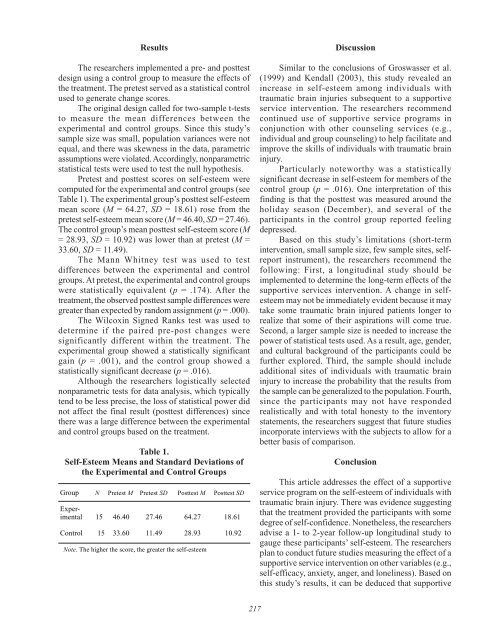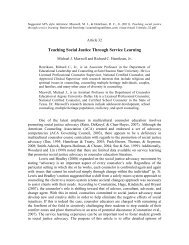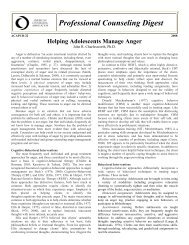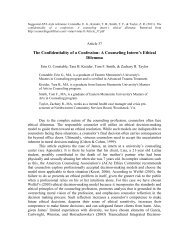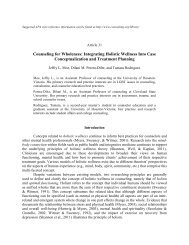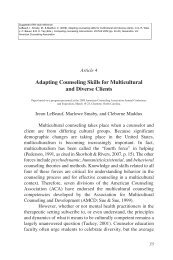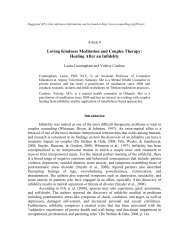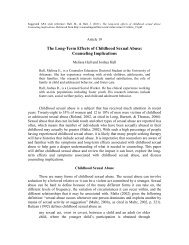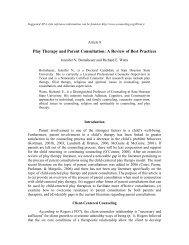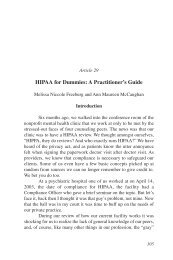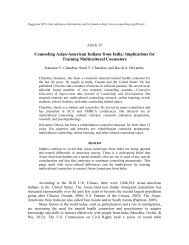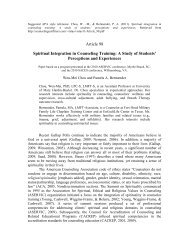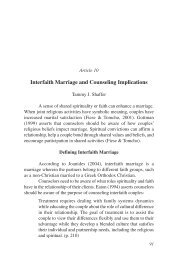VISTAS Online - Counseling Outfitters
VISTAS Online - Counseling Outfitters
VISTAS Online - Counseling Outfitters
Create successful ePaper yourself
Turn your PDF publications into a flip-book with our unique Google optimized e-Paper software.
Results<br />
The researchers implemented a pre- and posttest<br />
design using a control group to measure the effects of<br />
the treatment. The pretest served as a statistical control<br />
used to generate change scores.<br />
The original design called for two-sample t-tests<br />
to measure the mean differences between the<br />
experimental and control groups. Since this study’s<br />
sample size was small, population variances were not<br />
equal, and there was skewness in the data, parametric<br />
assumptions were violated. Accordingly, nonparametric<br />
statistical tests were used to test the null hypothesis.<br />
Pretest and posttest scores on self-esteem were<br />
computed for the experimental and control groups (see<br />
Table 1). The experimental group’s posttest self-esteem<br />
mean score (M = 64.27, SD = 18.61) rose from the<br />
pretest self-esteem mean score (M = 46.40, SD = 27.46).<br />
The control group’s mean posttest self-esteem score (M<br />
= 28.93, SD = 10.92) was lower than at pretest (M =<br />
33.60, SD = 11.49).<br />
The Mann Whitney test was used to test<br />
differences between the experimental and control<br />
groups. At pretest, the experimental and control groups<br />
were statistically equivalent (p = .174). After the<br />
treatment, the observed posttest sample differences were<br />
greater than expected by random assignment (p = .000).<br />
The Wilcoxin Signed Ranks test was used to<br />
determine if the paired pre-post changes were<br />
significantly different within the treatment. The<br />
experimental group showed a statistically significant<br />
gain (p = .001), and the control group showed a<br />
statistically significant decrease (p = .016).<br />
Although the researchers logistically selected<br />
nonparametric tests for data analysis, which typically<br />
tend to be less precise, the loss of statistical power did<br />
not affect the final result (posttest differences) since<br />
there was a large difference between the experimental<br />
and control groups based on the treatment.<br />
Table 1.<br />
Self-Esteem Means and Standard Deviations of<br />
the Experimental and Control Groups<br />
Group N Pretest M Pretest SD Posttest M Posttest SD<br />
Experimental<br />
15 46.40 27.46 64.27 18.61<br />
Control 15 33.60 11.49 28.93 10.92<br />
Note. The higher the score, the greater the self-esteem<br />
217<br />
Discussion<br />
Similar to the conclusions of Groswasser et al.<br />
(1999) and Kendall (2003), this study revealed an<br />
increase in self-esteem among individuals with<br />
traumatic brain injuries subsequent to a supportive<br />
service intervention. The researchers recommend<br />
continued use of supportive service programs in<br />
conjunction with other counseling services (e.g.,<br />
individual and group counseling) to help facilitate and<br />
improve the skills of individuals with traumatic brain<br />
injury.<br />
Particularly noteworthy was a statistically<br />
significant decrease in self-esteem for members of the<br />
control group (p = .016). One interpretation of this<br />
finding is that the posttest was measured around the<br />
holiday season (December), and several of the<br />
participants in the control group reported feeling<br />
depressed.<br />
Based on this study’s limitations (short-term<br />
intervention, small sample size, few sample sites, selfreport<br />
instrument), the researchers recommend the<br />
following: First, a longitudinal study should be<br />
implemented to determine the long-term effects of the<br />
supportive services intervention. A change in selfesteem<br />
may not be immediately evident because it may<br />
take some traumatic brain injured patients longer to<br />
realize that some of their aspirations will come true.<br />
Second, a larger sample size is needed to increase the<br />
power of statistical tests used. As a result, age, gender,<br />
and cultural background of the participants could be<br />
further explored. Third, the sample should include<br />
additional sites of individuals with traumatic brain<br />
injury to increase the probability that the results from<br />
the sample can be generalized to the population. Fourth,<br />
since the participants may not have responded<br />
realistically and with total honesty to the inventory<br />
statements, the researchers suggest that future studies<br />
incorporate interviews with the subjects to allow for a<br />
better basis of comparison.<br />
Conclusion<br />
This article addresses the effect of a supportive<br />
service program on the self-esteem of individuals with<br />
traumatic brain injury. There was evidence suggesting<br />
that the treatment provided the participants with some<br />
degree of self-confidence. Nonetheless, the researchers<br />
advise a 1- to 2-year follow-up longitudinal study to<br />
gauge these participants’ self-esteem. The researchers<br />
plan to conduct future studies measuring the effect of a<br />
supportive service intervention on other variables (e.g.,<br />
self-efficacy, anxiety, anger, and loneliness). Based on<br />
this study’s results, it can be deduced that supportive


